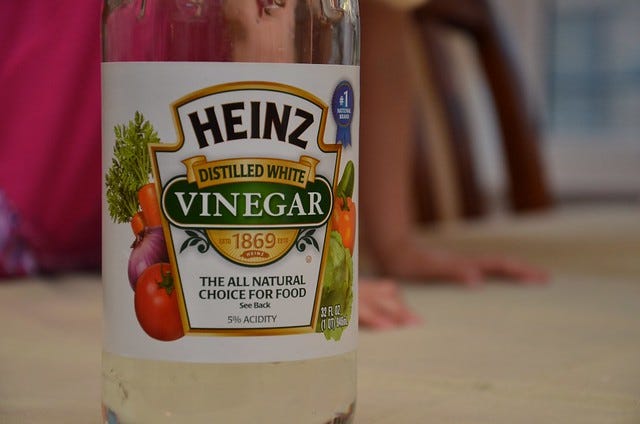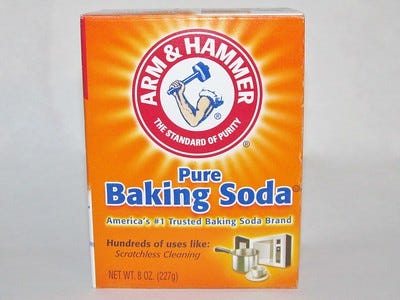Which cleaner to use for which problem?
Instead of applying vinegar and baking soda willy-nilly
Soap, acid, baking soda, enzymes - when to use what? Let’s go!
When to use Soap
This is an easy one. You may remember this from high school science! Soap is your best bet against oils and oily foods. Trying to clean a greasy pan with only water is ineffective since the water will simply slide off the surface leaving the oily particles behind. It is very hard for oil and water to interact with one another since they have nothing in common. Water molecules are polar (it has positive and negatively charged ends) while oil molecules are nonpolar. The water molecules like to surround themselves with other water molecules, forming hydrogen bonds, and exclude the oil molecules. This is where soap comes in.
A soap molecule is adept at blending oil and water due to its dual nature. It has a polar head at one end that is attracted to water molecules. Conversely, the other end of the soap molecule is a long hydrophobic tail, similar to oil. This tail repels water but is attracted to grease on surfaces like pans. Working in tandem, the head and tail of the soap molecule lift oil particles from the surface and suspend them in the water. With the continued flow of water, these suspended oil droplets are washed away, leaving your dish clean.
When to use Vinegar (or other acids)
If you see deposits on a hot water flask or water heater, they are called limescale. This happens when hard water evaporates or is heated, causing the minerals to form spots on glass or other surfaces. If you have hard water at home, you might also see soap scum on dishes. This forms when soap combines with minerals like calcium and magnesium in the water. Acids can react with these minerals to create a soluble salt that washes away.
Pooja silverware can be made to shine using abrasive acid based cleaners (like tamarind powder, pitambari, etc). Acids have the ability to break down and dissolve rust, making it easier to remove from the surface. With the dull, oxidized layer removed, the underlying shiny metal surfaces are revealed.
One of my foster dogs came back for a visit with such a layer of mineral deposits on his water bowl. I scrubbed it with vinegar and instantly it became its shining old self again. I was so thrilled, followed by…”dang, I should have captured that transformation on camera” :). My daughter had an old rusty ninja-training practice sword. Again, a few wipes with vinegar and back to its shiny self.
When to use Baking Soda
Baking soda is an alkaline compound, meaning it has a high pH (of about 8). When mixed with water or in a solution, it reacts with acidic components in proteins. This reaction causes denaturation, which alters the structure of proteins and leads to their breakdown to some degree.
Thus baking soda is a great option to remove heavily bonded proteins on cookware (milk proteins stuck to chai barthans, thick dal pastes bonded to the cookware bottom, etc). It also works as a mild abrasive agent. When scrubbed, it's fine particles help gently lift dirt and grime without scratching surfaces. We can move further up the alkaline scale (Ammonia solutions - pH 11, bleach - pH 12) for increased cleaning efficacy, but the higher we go, the harsher its effects on our skin and lungs upon contact.
Enzyme cleaners (for cat pee and what not)
Enzyme cleaners are a thing! It is not some non-science mumbo-jumbo invented by Instagram aunties (with all due respect to IG aunties), but a hard core…this is completely new territory-level science! I went down a rabbit hole to see how enzyme cleaners are made and after reading about “Enzyme immobilization” and “Directed evolution”; I kind of gave up.
This is the short spiel. Companies are now using enzymes to do their cleaning for them (dishwashing, laundry, floor cleaning, etc). Basically, they create this helpful bacteria which under the right conditions produce enzymes. These enzymes work like little robots breaking down starches (using amylase) and proteins (using protease). They work best between 35-45C. The enzymes do not work at high temperatures, plus they take a bit longer than detergents to do their job. This is why the Eco mode in the dishwasher takes such a long time!! Plus this is why cat pee cleaners advise you to leave it in for a min of 15 minutes. These guys eat all the organic matter in sight - pee, food, blood, etc. But, when released down the drain, they don’t wreak havoc on waterways unlike phosphate detergents.
You read the above para, and you are like…fair enough! But how? How are they manufacturing these tiny things in a large scale? How are they keeping these enzymes alive in a mix of soap and bleach? How does it know when to start eating? And then they eat the stuff and just die? At some point, will they gather and hold a revolution? The things that take up space in my brain!….anyways, science is just so, so cool! I will never cease to be amazed!
Conclusion
Finally, effective cleaners contain multiple ingredients to provide a combination of cleaning properties. In reality, you never have dishes with just fat droplets on them, you have dishes with fat, protein and mineral deposits on them. Tinker around with different cleaners and see what works.
When I went from “Ugh, cleaning…” to “Ooh, let me breakdown this particle with the right chemical”; I knew I unlocked the next nerd level!:)
What is your favorite cleaner? Post your comments below!







Very useful information. Self starters (not to mention nerds)like me (unlike those who learned cooking, and cleaning up after, from their elders who had access to such knowledge informally) need to understand how things work to be better at it. Thank you for this!
Thanks so much Swetha! Great to be able to get rid of that eggy smell from my dishes and the kitchen sink with baking soda (I’ve always used vinegar with only moderate success). Love to know how the science behind why it works! Thanks again.